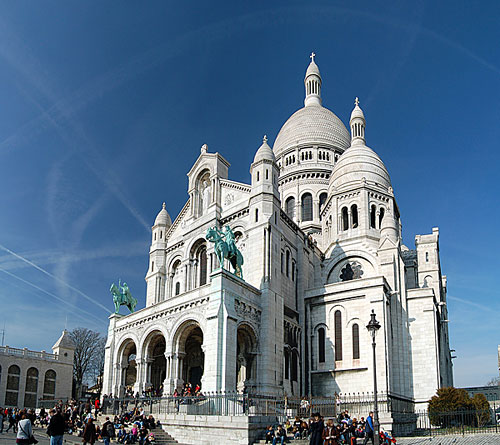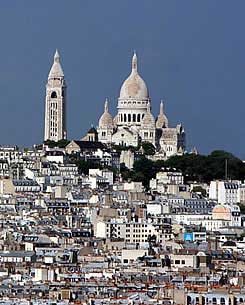The snowy white dome of the Basilique du Sacre-Coeur sits majestically atop the arty district of Montmartre, surveying the city of Paris.
Distinctive and imposing, the basilica was built between 1870 and 1919, by the French government as a symbol of the return of self-confidence after the devastating years of the Commune and Franco-Prussian War and to reassert the power of the Catholic Church.
Often called gaudy by the critics, Sacre-Coeur was designed by architect Paul Abadie. He borrowed elements from all over the place from Romanesque to Byzantine which gives the rather striking aesthetic. Construction took quite a while and the church was finally consecrated in 1919.

While the Eiffel Tower may be taller, the views from the basilica can't be beaten - 50 km on a clear day, fewer tourists and it's cheaper!
Today, the Sacre-Coeur is one of the most popular tourist destinations in Paris which unfortunately comes with some disadvantages: people who will want to make easy money of tourists.
A good example is some men that stand outside the Basilique, trying to give bracelets or other worthless trinkets to unsuspecting tourists. Once the prey has it the seller will start yelling for payment. A lot of people end up paying for them to stop,or out of embarrassment. We suggest just not to receive anything.
Don't get too seduced by the views and miss spending some time inside Sacre-Coeur though. The massive golden mosaic set high above the choir is definitely worthy of some awed gazing.
The largest and most eye-catching mosaic was created in 1922 by Luc-Olivier Merson. Called Christ in Majesty it is meant to symbolize France's devotion to the Sacred Heart. Whether you are religious or not, it is hard to tear your eyes away from it.
Other things to see include the gorgeous stained glass windows (more about them below), the basilica's crypt with the never-ending vaulted arches and the bronze doors depicting various Bible favorites such as the Last Supper.
Sacre-Coeur also boasts one of the world's heaviest bells. High up the in 262 foot-high tower hangs the one and only La Savoyarde, weighing in at an impressive 19 tons.
Montmartre, the neighborhood where Sacre-Coeur stands was, until recently, a village in its own right. This means that there are delightful, narrow, cobblestone streets and hidden gardens and vineyards to explore in the most poetry-drenched spot in Paris. It is famous for the writers and painters like Pablo Picasso, Salvador Dali among others that lived and worked here.
The best time to visit Sacre-Coeur is in mornings and evenings. Perhaps it better to avoid in on Sundays, since it will be most crowded.

If you don’t fancy walking up the steps to the basilica (which can be taxing, especially in the warm weather) you can take the funicular up.
Departing from rue Tardieu the glass-covered funicular can take you all the way to the top of Montmartre. Operated by the RATP, the funicular functions similar to a ski lift and can be ridden with a normal metro ticket.
Sacre-Coeur opens daily from 6 am to 11 pm and the daily mass takes place at 10pm. On Sundays mass is at 11am and 6pm.
It is a fact, that has almost become modern folklore amongst the local people, that during the Second World War a total of 13 bombs exploded in the vicinity of Sacre-Coeur and miraculously, no one was ever injured.
The stained-glass windows, which were installed in 1922, were destroyed by one of the bombings but none ever resulted in any casualties.
The windows were rebuilt in 1946 and Sacre-Coeur has held a certain status amongst Parisians ever since.